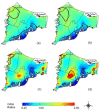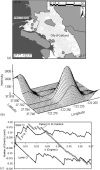Spatial modeling in environmental and public health research
- PMID: 20617032
- PMCID: PMC2872363
- DOI: 10.3390/ijerph7041302
Spatial modeling in environmental and public health research
Abstract
THIS PAPER HAS TWO AIMS: (1) to summarize various geographic information science methods; and (2) to provide a review of studies that have employed such methods. Though not meant to be a comprehensive review, this paper explains when certain methods are useful in epidemiological studies and also serves as an overview of the growing field of spatial epidemiology.
Keywords: GIS; air pollution; autocorrelation; overlay; remote sensing; spatial modelling; spatial regression.
Figures
















References
-
- Mayer JD. The role of spatial-analysis and geographic data in the detection of disease causation. Soc. Sci. Med. 1983;17:1213–1221. - PubMed
-
- Jerrett M, Finkelstein M. Geographies of risk in studies linking chronic air pollution exposure to health outcomes. J. Toxicol. Environ. Health Pt A. 2005;68:1207–1242. - PubMed
-
- Jerrett M, Gale S, Kontgis C. An environmental health geography of risk. In: Brown T, McLafferty S, Moon G, editors. A Companion to Health and Medical Geography. 1st ed. Wiley-Blackwell; West Sussex, UK: 2010. pp. 418–445.
-
- Bailey TC, Gatrell AC. Interactive Spatial Data Analysis. Longman; Harlow, UK: 1995. - PubMed
-
- Clarke K. Prentice Hall: Upper Saddle River, NJ, USA; 1998. Getting Started with GIS.
Publication types
MeSH terms
Grants and funding
LinkOut - more resources
Full Text Sources

